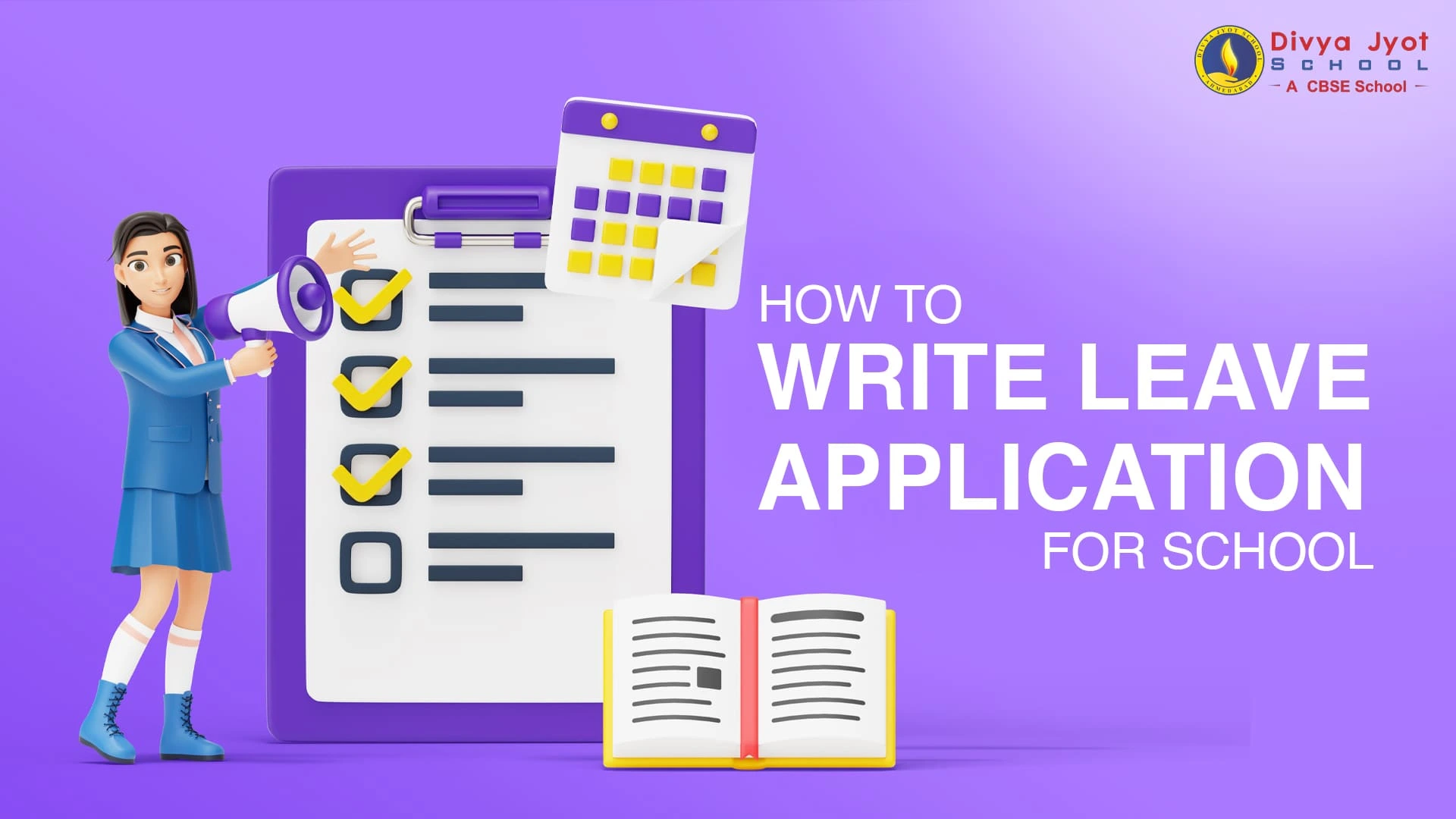Ask yourself why you need a guide to write a note telling your child that he/she was absent, since it is not only a note but also a significant part of communication that creates trust and respect between you and the school of your child.
An effective leave application for school does three important things: it guarantees that your child has an official leave, it keeps the records of your child intact, and, most importantly, it helps in showing that you appreciate the school rules and procedures. It is a minor gesture that instills discipline and teaches a child responsibility.
Let us deconstruct the process of creating the ideal one.
What is a Leave Application for School?
The formal, official method of asking the school to give you some time off is to write a leave application. It is not a skimpy text or an informal note; it is a formal document that demonstrates respect for the rules of the school and ensures that the absence of your child is duly noted.
This formal application to principal is crucial for extended or planned absences. It is not the same as a mere leave note, which can be informal and applied in quite short-term and unforeseen cases (such as one sick leave day). Using the application generates a paper trail, which proves responsibility and clarity in communication between the parents and the school.
The Standard Blueprint for a School Leave Application
Getting the leave application format right is key. Here’s the exact structure schools expect, whether written by a parent or an older student.
The Universal Structure:
Header: Your address & the date.
Receiver’s Info: The Principal’s/Teacher’s name, school name, and address.
Subject Line: The most critical part. Be specific. E.g., “Subject: Leave Application for [Student Name] – [Dates of Leave]”
Salutation: “Respected Sir/Madam,” or “Dear [Teacher’s Name],”
The Body:
Who & When: State your child’s name, class, section, and the exact dates of absence.
The Why: Clearly state the reason (family event, medical, etc.).
The Assurance: Add a line about taking responsibility for missed work.
Closing:
“Thanking you,” or “Sincerely,” followed by your signature, printed name, and contact number.
Pro Insight: For older students, the application should be from them (e.g., “I, Raj Sharma…request leave…”). For younger children, it’s from the parent (“I am writing to request leave for my son…”). This subtle shift shows maturity and understanding of protocol. This is the core of how to write leave letter effectively.
Common Types of School Leave Applications (With Ready-to-Use Templates)
1. The Standard Sick Leave (1-2 Days)
Use Case: For sudden, short-term illness like a fever or cold.
Pro Tip: Keep it brief but informative. No need for dramatic details.
Template: Application for Sick Leave
[Date]
The Class Teacher
[Class and Section]
[School Name]
Subject: Application for absent due to sickness
Respected Ma’am,
Please grant my son/daughter, [Student Name], roll number [##], leave for one day on [Date] as he/she is suffering from a high fever.
Thank you for your understanding.
Yours sincerely,
[Parent’s Name]
[Contact Number]
2. The Formal Medical Leave (Extended Absence)
Use Case: For a prolonged illness, hospital visit, or medical procedure.
Pro Tip: Mentioning a doctor’s note adds formality and assures the school of a genuine reason.
Template: Medical Leave Application for Student
[Date]
The Principal
[School Name]
[School Address]
Subject: Medical leave application for student for [Number] days
Respected Sir/Madam,
I am writing to inform you that my daughter, [Student Name] of Class [X]-[Section], has been diagnosed with [e.g., severe flu] and is under medical supervision. The doctor has advised complete rest from [Start Date] to [End Date].
We will submit the doctor’s note upon her return and will ensure she completes all missed assignments.
Thank you for your consideration.
Sincerely,
[Parent’s Name]
[Parent’s Signature]
[Contact Number]
3. The Short Planned Absence
Use Case: For a family event, short trip, or minor appointment.
Pro Tip: Being transparent about a “family function” or “short trip” is always better than being vague.
Template: Application for Two Days Leave
[Date]
The Class Teacher
[Class and Section]
[School Name]
Subject: Application for two days leave
Dear [Teacher’s Name],
I request you to kindly grant my son, [Student Name], leave for two days on [Date] and [Date] due to a family function out of town.
I will ensure he catches up on all lessons upon his return.
Thank you.
Yours faithfully,
[Parent’s Name]
[Contact Number]
4. The Emergency Leave
Use Case: For unforeseen circumstances requiring immediate absence.
Pro Tip: Communicate urgency without oversharing private details. A phone call often precedes this note.
Template: Application for Urgent Leave
[Date]
The Principal
[School Name]
Subject: Urgent leave request for [Student Name]
Respected Sir/Madam,
I request you to grant my child, [Student Name], Class [X], immediate leave for today, [Date], due to an unforeseen family emergency.
We appreciate your flexibility and will inform you of any extension if necessary.
Sincerely,
[Parent’s Name]
[Contact Number]
Who to Address? Tailoring Your Leave Application’s Tone
1. Formal: Application to Principal
When: For long absences (3+ days), official matters, or serious issues.
Tone: Highly formal and respectful.
Format: Use full addresses, a clear subject line, and a formal salutation/closing (“Respected Sir/Madam,” “Sincerely,”). This is a formal record for the school files.
2. Semi-Formal: Leave Letter to Class Teacher
When: For short absences (1-2 days), you know the teacher will handle it directly.
Tone: Respectful but can be slightly more direct and personal.
Format: Can be an email or note. “Dear Mrs. Sharma,” is perfect. Briefly state the reason and dates. It’s more of a direct notification.
3. Informal: Note to a Subject Teacher
When: For missing a single class or period (e.g., for a doctor’s appointment).
Tone: Concise and courteous.
Format: Often a quick email or handwritten note. “Dear Mr. Lee, [Student Name] will miss your history class today at 11 AM for a medical appointment. Thank you.”
Pro Tips for a Flawless Leave Application
Mastering how to write leave letter effectively is about nuance. Here’s what separates a good note from a great one.
- Clarity is King: Specify the name and class of the student and the actual days he/she is absent. Remove all ambiguity.
- Respectful Tone: It is always necessary to use polite words such as “Respected Sir/Madam” and “Thank you for your consideration.” This is a formal courtesy that cannot be negotiated.
- Proofread Ruthlessly: You have one spelling mistake in your message, and it spoils everything. Read it aloud before sending.
- Be Truthful but Private: Be honest and do not reveal too much about yourself. A vague excuse is not as good as a family function.
- Take Ownership: The statement that one always says that one will make the missing work done is very much appreciated and an active responsibility.
Avoid These Common Leave Letter Blunders
Even with the best template, small errors can make an application look unprofessional. Steer clear of these common pitfalls.
- The Weak Subject Line: “Leave Application” is weak. Always include the student’s name and the dates for immediate clarity.
- Missing Key Details: Forgetting the date on the letter, the student’s class, or roll number creates unnecessary back-and-forth for the admin office.
- The Overly Casual Tone: Using slang, abbreviations (“BTW”), or informal greetings (“Hey!”) shows a lack of respect for the formal process.
- The Mystery Absence: Simply stating “due to personal reasons” sounds evasive. A slightly more specific reason like “for a family commitment” is more professional and credible.
- No Ownership: Failing to include a line about taking responsibility for missed work makes the application feel incomplete and inconsiderate.
Conclusion
Crafting the perfect leave application for school is a simple but crucial skill. It’s the mark of a responsible parent and a teachable moment for students about professionalism and respect.
Your Key Takeaways:
Format is Fundamental: Follow the standard structure for clarity and professionalism.
Tone Matters: A respectful application to the principal or teacher ensures your request is taken seriously.
Details are Key: Specific dates and a genuine reason prevent delays.
Use the Templates: Don’t start from scratch. Our ready-to-use templates are designed for swift approval.
Ready to Write? Use the guidelines and templates above to create a polished leave letter that gets approved every time. Clear communication is the fastest path to permission.




